索尼WALKMAN说明书NWZ-W273
- 格式:pdf
- 大小:501.76 KB
- 文档页数:2
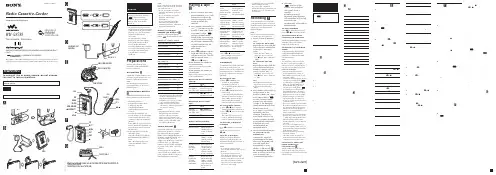
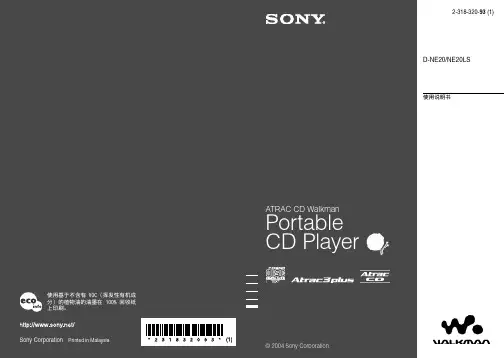

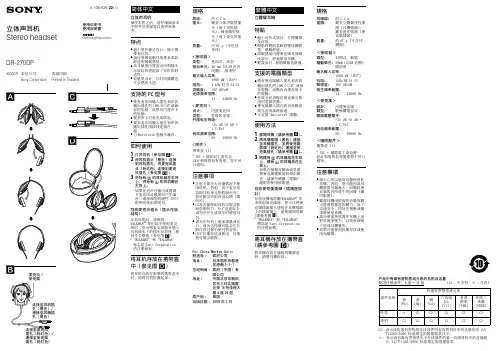
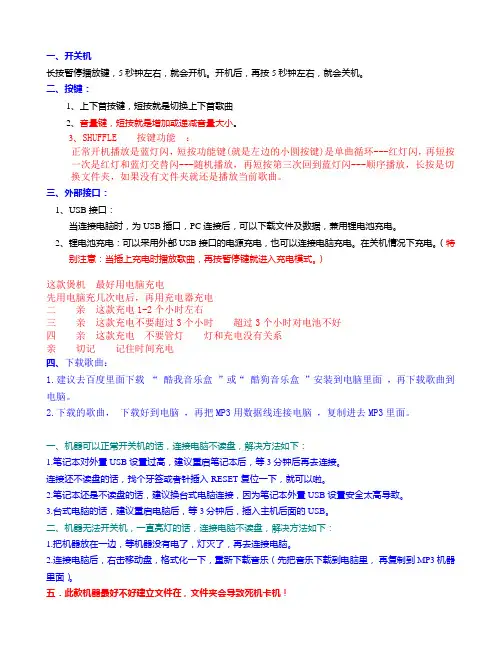
一、开关机长按暂停播放键,5秒钟左右,就会开机。
开机后,再按5秒钟左右,就会关机。
二、按键:1、上下首按键,短按就是切换上下首歌曲2、音量键,短按就是增加或递减音量大小。
3、SHUFFLE 按键功能:正常开机播放是蓝灯闪,短按功能键(就是左边的小圆按键)是单曲循环---红灯闪,再短按一次是红灯和蓝灯交替闪---随机播放,再短按第三次回到蓝灯闪---顺序播放,长按是切换文件夹,如果没有文件夹就还是播放当前歌曲。
三、外部接口:1、USB接口:当连接电脑时,为USB插口,PC连接后,可以下载文件及数据,兼用锂电池充电。
2、锂电池充电:可以采用外部USB接口的电源充电,也可以连接电脑充电。
在关机情况下充电。
(特别注意:当插上充电时播放歌曲,再按暂停键就进入充电模式。
)这款煲机最好用电脑充电先用电脑充几次电后,再用充电器充电二亲这款充电1-2个小时左右三亲这款充电不要超过3个小时超过3个小时对电池不好四亲这款充电不要管灯灯和充电没有关系亲切记记住时间充电四、下载歌曲:1.建议去百度里面下载“酷我音乐盒”或“酷狗音乐盒”安装到电脑里面,再下载歌曲到电脑。
2.下载的歌曲,下载好到电脑,再把MP3用数据线连接电脑,复制进去MP3里面。
一、机器可以正常开关机的话,连接电脑不读盘,解决方法如下:1.笔记本对外置USB设置过高,建议重启笔记本后,等3分钟后再去连接。
连接还不读盘的话,找个牙签或者针插入RESET复位一下,就可以啦。
2.笔记本还是不读盘的话,建议换台式电脑连接,因为笔记本外置USB设置安全太高导致。
3.台式电脑的话,建议重启电脑后,等3分钟后,插入主机后面的USB。
二、机器无法开关机,一直亮灯的话,连接电脑不读盘,解决方法如下:1.把机器放在一边,等机器没有电了,灯灭了,再去连接电脑。
2.连接电脑后,右击移动盘,格式化一下,重新下载音乐(先把音乐下载到电脑里,再复制到MP3机器里面)。
五.此款机器最好不好建立文件在,文件夹会导致死机卡机!。
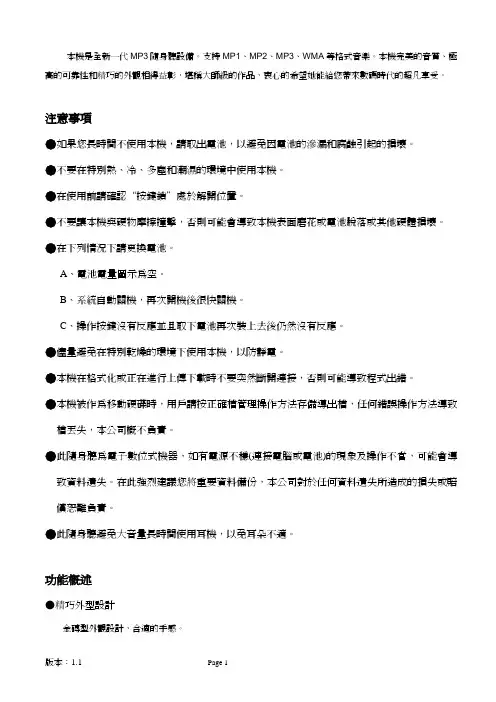
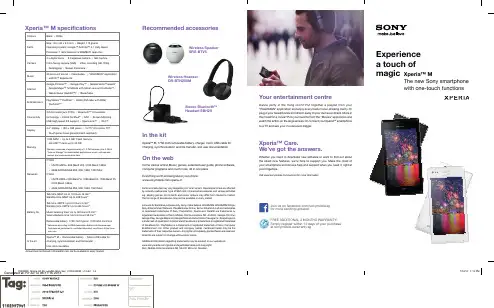
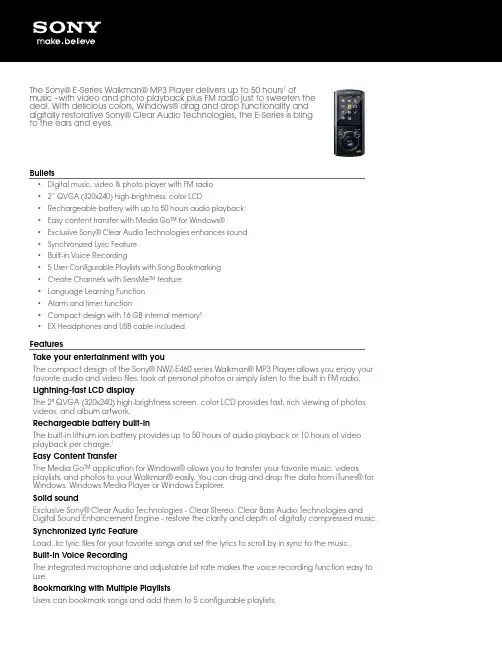
The Sony® E-Series Walkman® MP3 Player delivers up to 50 hours1 ofmusic –with video and photo playback plus FM radio just to sweeten thedeal. With delicious colors, Windows® drag and drop functionality anddigitally restorative Sony® Clear Audio Technologies, the E-Series is blingto the ears and eyes.Bullets• Digital music, video & photo player with FM radio• 2” QVGA (320x240) high-brightness, color LCD• Rechargeable battery with up to 50 hours audio playback1• Easy content transfer with Media Go™ for Windows®• Exclusive Sony® Clear Audio Technologies enhances sound• Synchronized Lyric Feature• Built-in Voice Recording• 5 User Configurable Playlists with Song Bookmarking• Create Channels with SensMe™ feature• Language Learning Function• Alarm and timer function• Compact design with 16 GB internal memory2• EX Headphones and USB cable includedFeaturesTake your entertainment with youThe compact design of the Sony® NWZ-E460 series Walkman® MP3 Player allows you enjoy your favorite audio and video files, look at personal photos or simply listen to the built in FM radio. Lightning-fast LCD displayThe 2" QVGA (320x240) high-brightness screen, color LCD provides fast, rich viewing of photos, videos, and album artwork.Rechargeable battery built-inThe built-in lithium ion battery provides up to 50 hours of audio playback or 10 hours of video playback per charge.1Easy Content TransferThe Media Go™ application for Windows® allows you to transfer your favorite music, videos, playlists, and photos to your Walkman® easily. You can drag and drop the data from iTunes® for Windows, Windows Media Player or Windows Explorer.Solid soundExclusive Sony® Clear Audio Technologies - Clear Stereo, Clear Bass Audio Technologies and Digital Sound Enhancement Engine - restore the clarity and depth of digitally compressed music. Synchronized Lyric FeatureLoad .lrc lyric files for your favorite songs and set the lyrics to scroll by in sync to the music.Built-in Voice RecordingThe integrated microphone and adjustable bit rate makes the voice recording function easy to use.Bookmarking with Multiple PlaylistsUsers can bookmark songs and add them to 5 configurable playlists.SpecificationsCreate Channels with SensMe™ featureSensMe™ tone analysis keeps your music in tune with your mood. SensMe software application automatically groups your music into channels based on beats-per-minute, making listening and managing your content even simpler.Language Learning FunctionLearning a new language is made easier thanks to the adjustable playback speed control, A-B repeat and rewind functions.Keep track of timeThe NWZ-E460 Walkman® player has a built in clock function with alarm and sleep timer.Big Storage CapacityStreamlined for portability, the NWZ-E464 can store hours of music, videos and personal photos thanks to the internal 16 GB memory 2.Open, charge and listenEverything you needs is in the box including USB cable and soft hybrid silicone EX headphones.1. Actual battery life will vary based on product settings, usage patterns and environmental conditions.2. 1 GB equals 1 billion bytes, a portion of which is used for data management functions.© 2011 Sony Electronics Inc. All rights reserved. Sony, Walkman, SensMe and the Sony logo are trademarks of Sony. Windows is a trademark of Microsoft Corporation. iTunes is a trademarkof Apple Inc . All other trademarks are property of their respective owners. Features and specifications are subject to change without notice. Updated: October 28, 2011。
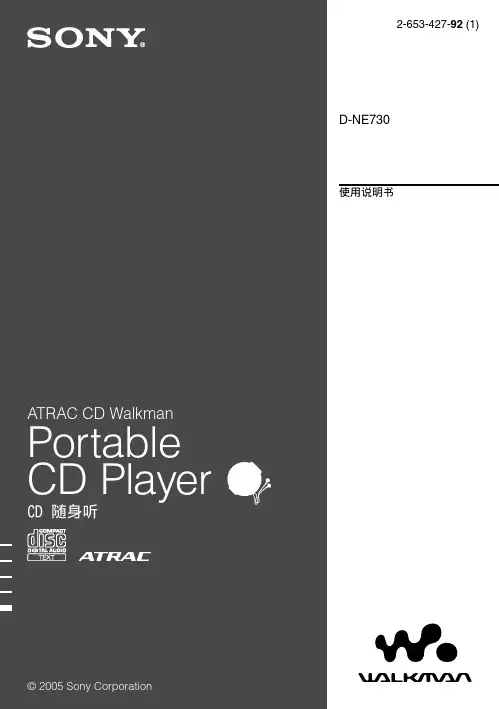

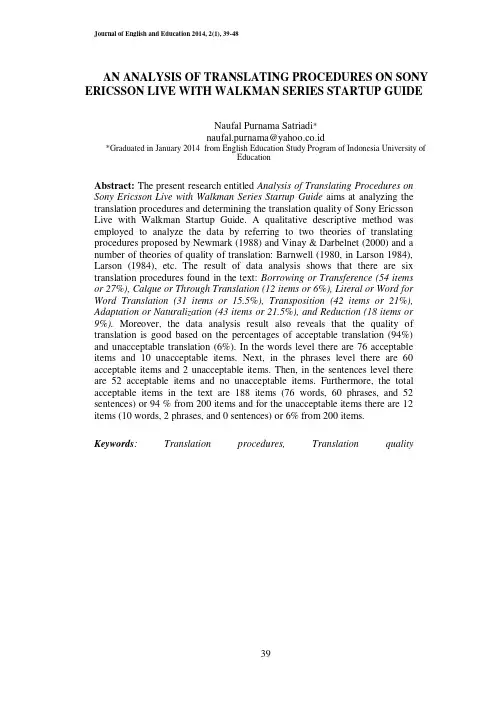
Journal of English and Education 2014, 2(1), 39-48AN ANALYSIS OF TRANSLATING PROCEDURES ON SONY ERICSSON LIVE WITH WALKMAN SERIES STARTUP GUIDENaufal Purnama Satriadi************************.id*Graduated in January 2014 from English Education Study Program of Indonesia University ofEducationAbstract: The present research entitled Analysis of Translating Procedures on Sony Ericsson Live with Walkman Series Startup Guide aims at analyzing the translation procedures and determining the translation quality of Sony Ericsson Live with Walkman Startup Guide. A qualitative descriptive method was employed to analyze the data by referring to two theories of translating procedures proposed by Newmark (1988) and Vinay & Darbelnet (2000) and a number of theories of quality of translation: Barnwell (1980, in Larson 1984), Larson (1984), etc. The result of data analysis shows that there are six translation procedures found in the text: Borrowing or Transference (54 itemsor 27%), Calque or Through Translation (12 items or 6%), Literal or Word for Word Translation (31 items or 15.5%), Transposition (42 items or 21%), Adaptation or Naturalization (43 items or 21.5%), and Reduction (18 items or 9%). Moreover, the data analysis result also reveals that the quality of translation is good based on the percentages of acceptable translation (94%) and unacceptable translation (6%). In the words level there are 76 acceptable items and 10 unacceptable items. Next, in the phrases level there are 60 acceptable items and 2 unacceptable items. Then, in the sentences level there are 52 acceptable items and no unacceptable items. Furthermore, the total acceptable items in the text are 188 items (76 words, 60 phrases, and 52 sentences) or 94 % from 200 items and for the unacceptable items there are 12 items (10 words, 2 phrases, and 0 sentences) or 6% from 200 items.Keywords: Translation procedures, Translation qualityNaufal Purnama SatriadiAn Analysis of Translating Procedures on Sony Ericsson Live with Walkman Series Startup Guide IntroductionNowadays, translation has an important role especially for people in Indonesia. This is owing to the fact that only little information is available in Bahasa Indonesia. That is, a great deal of information is mostly presented in foreign languages, particularly in English (Choliludin, 2005, p.1). In many places in Indonesia, one can find many text books, journals, news articles, movies, and advertisements are addressed in English. This situation may become a barrier for someone who wants to get information from English texts.Based on the descriptions above, translation plays a crucial role for people to get information which is written in English. Regarding this, Weber (1984, p.3) says that translation is the process of transposition of a text written in a source language into a target language, which in this case is from English into Indonesian.Literature Review∙Definition of TranslationDefinitions of translation have been proposed by a number of translation experts. Regarding this, it is defined by Newmark (1988) that translation is “the process of rendering the meaning of a text into another language in a way that the author intended the text” (Newmark, 1998, p. 5). In addition, Bell (1991) states that translation is the replacement of a representation of a text in a second language (1991, p. 6).∙Translation ProceduresIt has been proposed by a number of translation theorists that a translator needs to use translation procedures translating a text (Newmark, 1988). In what follow is some procedures proposed by some translation theorists:1.Word-for-word translation,2.Transference or Borrowing,3.Calque or Through Translation,4.Transposition or Shift,5.Modulation,6.Equivalence,7.Naturalization,8.Cultural Equivalent,9.Functional Equivalent,10.Descriptive Equivalent,11.Synonymy,12.Recognized Translation,13.Translation Label,pensation,Journal of English and Education 2014, 2(1), 39-4815.Reduction and Expansion,16.Paraphrase,17.Couplets,18.Notes, Additions, Glosses.∙Criteria of a Good Translation Barnwell (1980) in Larson (1984) proposed that there are 3 main aspects ofa good translation:1.Accuracy2.Clarity3.NaturalnessThose 3 main aspects would be applied in this research in order to find out the translation quality of Sony Ericsson Live with Walkman Startup Guide.Methodology∙DesignThe research employed qualitative descriptive method as the research methodology. This is because the researcher analyzed the data descriptively and the presentation of the result was in a form of explanation of words which would be supported by data presented in the form of tables. With regard to the description above, it is indicated by Fraenkel and Wallen (2012, p.426) that a study that investigates the quality of relationships, activities, situations, or materials is frequently refer to as qualitative research Fraenkel and Wallen (2012, p.426).∙SampleIn conducting descriptive research, as suggested by Fraenkel and Wallen (1993) a researcher must at least have sample with a minimum number of 100 (Fraenkel and Wallen, 1993, p.83).The current research used 200 samples to be analyzed.∙Data CollectionThere were some steps in collecting the data:1.The researcher presented and listedthe translation of Sony EricssonLive with Walkman Startup Guide.In this step, the researcher countedall sentences in the manual bookand then selected 200 sentences tobe analyzed.2.The researcher read and learnedboth the English version and theIndonesian version of the selectedsentences. In this step, theresearcher analyzed the sentencesin order to find out the translationprocedure used in every selectedsentence.3.The researcher sought the relevanttheories related to translationprocedures and translation qualityfrom some books, literatures, andinternet sources.∙Data AnalysisAfter the data were collected, the data were analyzed to find the answers to the research questions. Furthermore, the collected data was analyzed by using the following steps:1.Juxtaposing the English versionand Indonesian version to checkthe translation2.Identifying and classifying thetranslation procedures accordingto their types, based on thetheoretical foundations that areproposed by some experts, whichhave been mentioned in chaptertwo.3.Calculating the total number andpercentage of each procedure tofind out the amount of eachprocedure based on the followingformula:x 100%P = Number of percentageF = Frequency of translation procedureN = Number of whole sample4.Judging the quality of thetranslation based on some theoriesdescribed in chapter two by usingthe same formula with the thirdstep. This step is supported bysome experts in determining thequality of translation.5.Drawing conclusionData Presentation and Discussion∙Translation Procedures in Sony Ericsson Live with WalkmanStartup GuideIn the end of the research, there were six translation procedures found in the text.Table 1 Percentages of the translation procedures in Sony Ericsson Live with Walkman Startup GuideJournal of English and Education 2014, 2(1), 39-48The table above shows the numerical data of the translation procedures that were employed in Sony Ericsson Live with Walkman Startup Guide. Based on this finding, it is very obvious that the procedures mostly used in the text, from the highest to the lowest percentages are borrowing/transference(56 items or 28%), adaptation/naturalization(42 items or 21%), transposition (42 items or 21%), literal/word for word (32 items or 16%), reduction(16 items or 8%), and Calque/through-translation(12 items or 6%).∙BorrowingThe first procedure is borrowing/transference. Borrowing of transference is a process of transferring the SL (Source Language) into the TL (Target Language) in which the words ofthe text become “loan words” because there is no change of form when transferring SL text into the TL (Vinay and Darbelnet, 2000). Some examples of borrowing found in the data analysis are presented in the following table:Table 2 Examples of Borrowing orTransference Translation ProcedureAll the SL words in the table above are not lexicalized into TL. They were transferred without changing the original forms because they had no equivalent meaning in the TL. That is, the words “headset”, “walkman”, ”sensor”, ”google”, “android market”, “nokia”, “symbian S60”, “IPhone”, “PC”, “ITunes”are easy to understand by the reader.∙AdaptationThe second translation procedure mostly found in translating the text is adaptation or Naturalization translation procedure. Adaptation or Naturalization is the procedure that succeeds, transfers, and adapts the SL word first to normal pronunciation, then to the normal morphology of the TL (Newmark, 1988). The examples of adaptation procedure investigated in the text are presented in the following table:Table 3 Examples of Adaptation or Naturalization Translation ProcedureThe examples in the table above were categorized as adaptation or naturalizationtranslationprocedurebecause all of them had been adapted to normal pronunciation and morphology of the TL. That is, most of Indonesian use those words in many occasions in their daily activities such as at work, at school, etc. The TL has almost the same sense of words with the SL; the translation resembles the SL form, so the meaning is delivered well. This case is relevant to the theory proposed by Newmark (1998, p.82).TranspositionThe next translation procedure that was found in the Sony Ericsson Live with Walkman Startup Guide is transposition .Transposition or Shift is a translation procedure that is proposed by Catford (1965) and Vinay and Darbelnet (2000). They assert that this is a kind oftranslation procedure which involves a change in the grammar from the SL to the TL. In what follows are some examples of transposition procedure:Table 4 Examples of Transpositiontranslation ProcedureIt can be seen clearly that there were changes position in the examples above. The translator chose transposition to translate those sentences in order to produce acceptable translations. With regard to this, if the translator applied word for word translation to translate the words, the meaning would be awkward. For example, if the phrase “step by step instructions” was translated “petunjuk langkah demi langkah” the translation was more acceptable and understandable than “langkah demi langkah petunjuk” in which the phrase “langkah de mi langkah petunjuk” was translated using word for wordtranslationprocedure.Thisexplanation goes with the theory suggested by Catford (1965) and Newmark (1988)whostatethatJournal of English and Education 2014, 2(1), 39-48transposition involves a change in the grammar from the SL to the TL.∙LiteralAnother translation procedure found in Sony Ericsson Live with Walkman Startup Guide was literal translation or word-for-word translation. This kind of translation procedure is considered as the easiest or the most effortless translation procedure (Fawcet, 1997, p.36). Regarding this, it is said that the TL was translated one-by-one and literally by their most common meanings, they also have no changes in their form (Newmark, 1998, p.45). The examples are presented in the following table: Table 5 Examples of Literal or Word-for-Word Translation ProcedureThe examples in the table above were categorized as literal or word-for-word translation because the translator translated completely all of the words so that the meaning was identical to the SL. This is relevant to the theory proposed by Newmark (1998) who stated that literal translation transfers SL text to the nearest equivalence of the TL text, meaning that this is also referred to as word for word translation.∙ReductionReduction is the omission of information considered to be unnecessary or unlikely to make sense to the target-language reader. It is in line with what Newmark (1988, p. 90) andFawcet (1997, p. 47) in which reduction is used to make simplicity in creating meaning. In this text, the amount of this procedure reached 16 items or 8%. Here are the examples of reduction translation procedure found in the manual translation:Table 6 Examples of ReductionTranslation ProcedureThe sentences above indicate omissions. In the examples above, the preposition “to” in all sentences, the word “your” in the sentence “to change your home screen wallpaper”, and the word “a” in the sentence “to end a call” w erenot translated. The translator might do it to omit unimportant parts. It is on the contrary to the expansion translation procedure because in the expansion translation procedure the text needs an addition to produce a clear translation i.e. the meaning seem sensible, as declared by Barnwell (1980 as cited in Larson 1984), and Nida and Taber (1982).∙CalqueThrough-translation is the literal translation of phrase or idiom (Newmark, 1988, p.46). Besides, Vinay and Darbelnet (2000) in Munday (2001) has another term for this translation procedure. Their term is known as calque. In this text, calque or through-translation was used in order to translate phrases or common collocations. Here are the examples of reduction translation procedure found in the manual translation:Table 7 Examples of Calque or Through-Translation Procedureabove were categorized as calque or through-translation translation procedure because they were common collocations. This is consistent with what Newmark (1998) and Vinay and Darbelnet (1995, in Munday, 2001) declare that through translation or calque is used to translate common collocations.∙Translation Quality in Sony Ericsson Live with WalkmanStartup GuideBased on data analysis, the frequency of acceptable translations reached 188 items or 94%. Meanwhile, the unacceptable translations were only 12 items or 6%. It proves that overall the translation quality of Sony Ericsson Live with Walkman Startup Guide was good or acceptable.Founded on the table 4.10, in the words column there are 76 acceptable items and 10 unacceptable items. Next, in the phrases column there were more acceptable items (60 items from 62 items) than unacceptable items (2 items from 62 items). Then, in the sentences column there are 52 items and no unacceptable items. Furthermore, the total acceptable items in the text are 188 items (76 words, 60 phrases, and 52 sentences) or 94 % from 200 items and for the unacceptable items there are 12 items (10 words, 2 phrases, and 0 sentence) or 6% from 200 items.Journal of English and Education 2014, 2(1), 39-48ConclusionsBased on the findings and discussion presented in the previous chapter, the research actually had reached its aims. Based on the result of data analysis, two points can be concluded. There are the conclusion of translation procedure and the translation quality of Sony Ericsson Live with Walkman Startup Guide. Firstly, for the translation procedures the researcher found several translation procedures applied by the translator. The findings, sorting from the highest to the lowest percentage are as follows: borrowing/transference(54 items or 27%), adaptation/naturalization (43 items or 21.5%), transposition(42 items or 21%), literal/word-for-word (31 items or 15.5%), reduction(18 items or 9%), and Calque/through-translation (12 items or 6%).Founded on the data analysis, the result showed that the translation quality of the text was good. From the samples, there were 94% or 188 items which were acceptable or had a good quality of translation and the rest were unacceptable (6% or 12 items). This result is supported by Barnwell (1980) in Larson (1984). In the words there are 76 acceptable items and 10 unacceptable items. Next, in the phrases there were more acceptable items (60 items from 62 items) than unacceptable items (2 items from 62 items). Then, in the sentences there are 52 items and no unacceptable items. Furthermore, the total acceptable items in the text are 188 items (76 words, 60 phrases, and 52 sentences) or 94 % from 200 items and for the unacceptable items there are 12 items (10 words, 2 phrases, and 0 sentence) or 6% from 200 items.ReferencesBell, R. T. (1991). Translation and Translating: Theory and Practice.London: Longman.Catford, J. C. (1965). A Linguistic Theory of Translation. London: OxfordUniversity Press.Choliludin.( 2005). The Technique of Making Idiomatic Translation.Jakarta: Kesaint Blanc. Fawcett.P. (1997). Translation and Language Linguistic TheoriesExplained. Manchester: St. JeromePublishing.)Fraenkel, J. R. and Wallen, N. G.(1993).How To Design EvaluateResearch in Education-SecondEdition. Singapore: Mc. Graw HillBook Co.Fraenkell, J. R, &Wallen N. E.(2012).How to Design andEvaluate Research in Education(Eight Ed.). New York: Mc. Graw-Hill International Edition. Larson, M. L. (1984). Meaning-Based Translation. New York: Universityof America.Munday, J. (2001). Introducing Translation Studies: Theories andApplications. London and NewYork: Routledge.Newmark, P. (1988). A Textbook of Translation. London: Prentice HallInternational.Nida, E. A. and Taber, Charles R. (1982).The Theory and Practice ofherlands: E. J.Brill, Leiden.Vinay, J, & Darbelnet, J. (2000). A Methodology for Translation.London: Routledge Weber, W. K. (1984). Training Translation and ConferenceInterpreters. New Jersey: PrenticeHall Regents.。
Perfect for indoor or outdoor training, the wireless one-piece W-SeriesMP3Player’s unique spiral form design comfortably stays put and out of theway while you work out. No more tangled headphones. A moisture-resistant seal keeps sweat out, while you enjoy true-to-life, deep basssound. So you can reach your personal best.Bullets• One-piece wearable music player for wire-free workouts• Water-resistant3 design holds up during intense workouts• Drag & drop from iTunes® (PC) or Windows® Media Player• Compact design with 4 GB internal memory2• 3-min quick charge = up to 60-min of battery life1• Easy navigation of songs & folders• Enjoy playlist compatibility (PC) & shuffle mode• Crystal clear sound and deep bass• ZAPPIN™ search plays about 4 or 15-second music clips• USB cable, holder and S/M/L ear-buds includedFeaturesWearable and Wire-freeThis one-piece music player’s unique band comfortably floats on the back of your neck, allowing you to be wire-free, hands-free, and without distraction whether you’re at the gym or outdoors working out.Water-resistant3The water resistant design is IPx5 rated and holds up to intense workouts.Drag, drop and goWith a Walkman player, you are never tied to just one music service. Just drag and drop MP3s from iTunes® for Windows®, Windows® Media Player or Internet Explorer® and enjoy. Now that’s freedom.Storage CapacityThe NWZ-W263 series can store hours of music thanks to the internal 4 GB memory2.Quick charge batteryUse the included USB cable to get up to 60 minutes of use on just 3 minutes of charge1. With an impressive total battery life of up to 8 hours on a full charge1, the NWZ-W263 is ready when you are.Navigate your song libraryGetting around in your music is simple with the rocker switch. A quick tap changes songs and a tap and hold changes folders while in all play mode. In playlist mode a quick tap changes songs and a tap and hold changes the playlist.Playlist compatibleCreate your favorite playlists in iTunes® for Windows® or Windows Media Player and drag them to the Walkman® player. Use shuffle mode to mix it up.High Quality SoundExclusive Sony Clear Audio Technologies – Clear Stereo and Clear Bass Audio Technologies for deeper, richer sound.Music to match your paceSpecificationsFind the perfect music for the moment using the ZAPPIN™ search feature, allowing you to easily navigate through your song collection by playing back main melodies.1. Actual battery life may vary based on product settings, usage patterns and environmental conditions. Battery capacity decreases over time and use.2. 1 GB equals 1 billion bytes, a portion of which is used for data management functions.3. Water-resistant certified to the IPX5 standard.© 2011 Sony Electronics Inc. All rights reserved. Reproduction in whole or in part without written permission is prohibited. Sony, Walkman, ZAPPIN, and the Sony logo are trademarks of Sony. Windows is a trademark of Microsoft Corporation. iTunes is a trademark of Apple Inc. All other trademarks are trademarks of their respective owners. Features and specifications are subject to change without notice. Updated: September 16, 2011。
Workout without wiresThis one-piece music player’s unique spiral form comfortably floatson the back of your neck, allowing you to be hands-free, cord-free, and without distraction whether you’re at the gym or outdoors working out. The built-in sound-isolating, 13.5mm EX headphones can be adjusted for fit with three included pairs of earbuds.Water-resistant2Water resistant design holds up during intense workouts.2Drag, drop and goEasily load your music by dragging and dropping music files fromiTunes , Windows Media Player, or Windows Explorer.® ® ®Simple navigation of your song libraryGetting around in your music is simple with the Jog Lever™ feature. A quick flip changes songs and a flip and hold changes folders while in all play mode. In playlist mode a quick flip changes songs and a flip and hold changes the playlist.Quick charge batteryUse the included USB cable to get up to a 90 minute charge in just 3 minutes. With an impressive total battery life of up to 11 hours , the W252 is ready when you are. 1 1 Music to match your paceFind the perfect music for the moment using the ZAPPIN™ search feature, allowing you to easily navigate through your song collection by playing back main melodies. Use the Jog Dial™ key to scroll and select your ideal track without the need for buttons.Sony Electronics Inc. • 16530 Via Esprillo • S an Diego, CA 92127 • 1.800.222.7669 • w Last Updated: 03/08/2011Please visit the Dealer Source for current information at/dealersourceFeaturesWorkout without wires This one-piece music player’s uniquespiral form comfortably floats on the back of your neck, allowing you to be hands-free, cord-free, and withoutdistraction whether you’re at the gym or outdoors working out. The built-in sound-isolating, 13.5mm EX headphones can be adjusted for fit with three included pairs of earbuds.Water-resistant Water resistant design holds up during intense workouts.2 2 Drag, drop and go Easily load your music by dragging and dropping music files from iTunes , Windows Media Player, or Windows Explorer.® ® ® Simple navigation of your song library Getting around in your music is simple with the Jog Lever™ feature. A quick flipchanges songs and a flip and hold changes folders while in all play mode. In playlist mode a quick flip changes songs and a flip and hold changes the playlist.Quick charge battery Use the included USB cable to get up to 90 minute charge in just 3 minutes. With an impressive total battery life of up to 11 hours, the W252 is ready when you are.1 1 Music to match your pace Find the perfect music for the moment using the ZAPPIN™ search feature, allowing you to easily navigate through your song collection by playing back main melodies. Use the Jog Dial™ key to scroll and select your ideal track without the need for buttons.SpecificationsGeneralMusic Storage Capacity (Approx): 1.68 GB (1,812,660,224 bytes)AudioAVLS: AVLS Volume Limit ON/OFFFormat(s) Supported: MP3/ AAC/ WMA (DRM)/ WMT Capable Frequency Response: 20 - 20,000Hz (when playing back data file, single signal measurement) Audio Power Output: 5 + 5mWAudio FeaturesPlay Mode: Normal / Shuffle / ZAPPIN™ (Short or Long)Convenience FeaturesMultiple Language Display: NoHardwareHeadphone Type: Closed, dynamic 13.5mm, dome type System Requirements: Computer:IBM PC/AT or compatible computer preinstalled with the following Windows operating systems:- Windows® XP Home Edition (Service Pack 2 or later) - Windows® XP Professional (Service Pack 2 or later) - Windows Vista® Home Basic (Service Pack 1) - Windows Vista® Home Premium (Service Pack 1) - Windows Vista® Business (Service Pack 1) - Windows Vista® Ultimate (Service Pack 1) Not supporting 64 bit version OS.Operating ConditionsOperating Temperature: 41 'F to 95 'F (5 'C to 35 'C)PowerBattery Indicator: LED Battery Life Indicator (Green/Orange/Red)Power Type: Built-in Rechargeable Li-ion BatteryBattery Life (Approx): Music: 11 hrs. (MP3 128kbps)Battery Charging (Approx): USB-based:Approx. 1.5 Hrs (full charge), Approx. 3 Minutes (approx. 90 minutes playback)Inputs and OutputsHeadphone Output(s): Cord Free DesignUSB Port(s): USB mini-B connecter Hi-Speed USB(USB 2.0 compliant)MemoryMemory Size: 2GBUser Memory Capacity (Approx.): 1.68 GB 1,812,660,224 bytesDimensionsWeight: Approx. 43g (Approx. 1.6 oz)Supplied AccessoriesEarbuds (S/M/L) Supplied in pairs.Operation Guide (1)USB cable (1)Holder (1)Notes on Water Resistant Specifications (1)UPC Code: 027*********1. Actual battery life may vary based on product settings, usage patterns and environmental conditions.2. Not to be immersed or come into continuous contact with water.© 2010 Sony Electronics Inc. All rights reserved. Reproduction in whole or in part without written permission is prohibited. Sony, Walkman, ZAPPIN, Jog Lever and the Sony logo are trademarks of Sony. Windows is atrademark of Microsoft Corporation. iTunes is a trademark of Apple Inc. All other trademarks are trademarks of their respective owners. Features and specifications are subject to change without notice. Non-metric weights and measures are approximate and may vary.1。
Music System BT 產品說明恭喜您購買了 Music System BT 藍牙 CD 播放機!我們相信這是現今市場上難得一見的高音質 CD 播放機,透過藍牙無線技術您還可以將手機音樂無線傳輸到 Music System BT 上。
對於您迫切希望使用新收音機的心情,我們非常理解,但在開始使用之前,請務必仔細閱讀本說明書內容與安全說明;若有任何疑問,請隨時聯繫您的經銷商或 Tivoli Audio。
請保留本產品外箱與原廠包裝,以防您需要寄送;因為運送途中的損壞不屬於出廠保固的範圍中。
再次感謝您選擇 Tivoli Audio,希望 Music System BT 能為您帶來快樂愉悅的音樂體驗!5SNOOZE / MUTE 貪睡 / 靜音(機器上方):當鬧鐘響起時按下此按鈕可使鬧鐘靜音 7 分鐘,螢幕顯示倒數計時剩餘的貪睡時間。
旋轉音量旋鈕將取消貪睡模式。
在正常操作情況下按此按鈕可將正在播放的聲音靜音。
螢幕將顯示"Muted",再按一下可關閉靜音恢復正常播放。
6.7,8,9,0:除了 1-6 按鈕外,還可使用這些按鈕直接選擇 CD 曲目;輸入第一個數字後於兩秒內輸入第二位數字即可。
遙控器上 1-6 按鈕可切換喜好電台。
使用上 / 下箭頭按鈕可控制音量,左 / 右箭頭(CD 曲目)按鈕控制 FM / AM 調頻電台。
在近距離操作遙控器時螢幕可能出現閃跳,此為正常現象。
若遙控器需要更換電池請使用 3V 鋰電池 #CR2025,安裝時正極面向遙控器底部。
目錄按住 Music System BT 上的音量旋鈕,或按住遙控器上的 MENU 按鍵,進入主選單。
旋轉旋鈕並按下以變更目錄中的選項,或使用遙控器的☐❑按鍵與選擇鍵。
1.AUTO SCAN 自動掃描(AUX 與 藍牙目錄無此選項):按下選擇按鈕並使用☐❑箭頭與選擇鍵啟動或關閉自動掃描。
啟動後每次按下☐❑箭頭時就會自動搜尋可收聽電台。
關閉時☐❑按鈕可用於手動調頻。